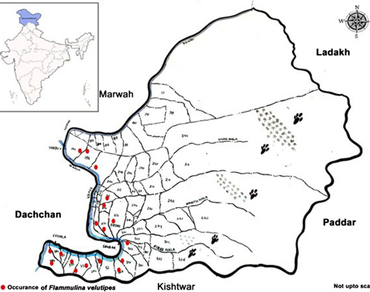Mycochemical composition and antioxidant activity of Flammulina velutipes: a comparative study on hydromethanol, decoction and infusion extracts
Research Articles | Published: 07 March, 2022
First Page: 607
Last Page: 613
Views: 3719
Keywords: Ethnic use, Macro-microscopic characterization, Radical scavenging activity, Secondary metabolites, Wild edible mushroom
Abstract
Jammu and Kashmir provide a pleasant environment for the lavish growth of diverse macrofungal groups where many members are ethnically appraised. Local people enjoy edible mushrooms due to their health beneficial effects ensuring food security for inhabitants. In this regard, a recent field survey was carried out by our team in Kishtwar High Altitude National Park, India gifting us several traditionally popular edible mushroom species. One of the collected samples was identified as Flammulina velutipes, as described herein, which was further subjected to isolation of various fractions to study myco-chemical composition and bioactivity. Our results showed that the decoction preparation was capable of better radical scavenging followed by hydro-methanol extract; while the infusion exhibited a promising effect on the chelating ability of metal ions. The outcome might be justified by the quantity of phenol which was in the utmost in decoction (14.85 μg gallic acid equivalent/mg of extract) followed by infusion preparation (12.02 μg gallic acid equivalent/mg of extract). On the other hand, lycopene (1.4 μg/mg of extract) and ascorbic acid (1.56 μg/mg of extract) were present in higher amounts in the hydro-methanol fraction. Thus, the studied mushroom could be considered as an easily accessible source of natural antioxidants that could be used in the pharmaceutical industry.

References
Alam MN, Bristi NJ, Rafiquzzaman M (2013) Review on in vivo and in vitro methods of evaluation of antioxidant activity. Saudi Pharm J 21:143–152
Banerjee SN (1947) Fungus and suburbs flora of Calcutta 1. Bull Bot Soc Bengal 1:37–54
Berkeley MJ (1856) Decades of fungi, Decas 1–62 Nos. 1–620. London J Bot 3–8:1844–1856
Debnath S, Debnath B, Das P, Saha AK (2019) Review on an ethnomedicinal practices of wild mushrooms by the local tribes of India. J Appl Pharm Sci 9:144–156
Khatua S, Paul S, Acharya K (2013) Mushroom as the potential source of new generation of antioxidant: a review. Res J Pharm Technol 6:496–505
Khatua S, Dutta AK, Acharya K (2015) Russula senecis: a delicacy among the tribes of West Bengal. PeerJ 3:e810
Khatua S, Dutta AK, Chandra S, Paloi S, Das K, Acharya K (2017a) Introducing a novel mushroom from mycophagy community with emphasis on biomedical potency. PLoS ONE 12:e0178050
Khatua S, Ghosh S, Acharya K (2017b) Chemical composition and biological activities of methanol extract from Macrocybe lobayensis. J Appl Pharm Sci 7:144–151
Khatua S, Ghosh S, Acharya K (2017c) A simplified method for microtiter-based analysis of in vitro antioxidant activity. Asian J Pharm 11:S327–S335
Khatua S, Sikder R, Acharya K (2018) Chemical and biological studies on a recently discovered edible mushroom: a report. FABAD J Pharm Sci 43(3):151–157
Khatua S, Acharya K (2018) Water soluble antioxidative crude polysaccharide from Russula senecis elicits TLR modulated NF-κB signalling pathway and pro-inflammatory response in murine macrophages. Front Pharmacol 9:Article 985
Kozarski M, Klaus A, Jakovljevic D, Todorovic N, Vunduk J, Petrović P, Niksic M, Vrvic MM, van Griensven L (2015) Antioxidants of edible mushrooms. Molecules 20:19489–19525
Kumar S, Sharma YP (2008) Three lignicolous macrofungi from district Doda of Jammu province (J&K), India. Environ Conserv J 3&4:1–5
Kumar S, Sharma YP (2009) Some potential wild edible macrofungi of Jammu Province (Jammu and Kashmir), India. Indian J For 32:113–118
Lalotra P, Bala P, Kumar S, Sharma YP (2016) Biochemical characterization of some wild edible mushrooms from Jammu and Kashmir. Proc Nat Acad Sci, India Sect B Biol Sci 88:539–545
Lourenço SC, Moldão-Martins M, Alves VD (2019) Antioxidants of natural plant origins: from sources to food industry applications. Molecules 24(22):4132
Molares S, Toledo CV, Stecher G, Barroetaveña C (2019) Traditional mycological knowledge and processes of change in Mapuche communities from Patagonia, Argentina: a study on wild edible fungi in Nothofagaceae forests. Mycologia 112:1–16
Sharma YP, Sharma R, Khatua S, Acharya K (2019) Morphotaxonomy and comparative mycochemical study and antioxidant activity of hydromethanol, infusion and decoction extracts from Russula brevipes Peck. Indian Phytopathol 72(3):445–452
Sitotaw R, Luleka E, Abate D (2020) Ethnomycological study of edible and medicinal mushrooms in Menge districts, Assossa zone, Benshangul Gumuz region, Ethiopia. J Ethnobiol Ethnomedicine 16:1–13
Tang C, Hoo PCX, Tan LTH, Pusparajah P, Khan TM, Lee LH, Goh BH, Chan KG (2016) Golden needle mushroom: a culinary medicine with evidenced-based biological activities and health promoting properties. Front Pharmacol 7:474
Ukaegbu CI, Shah SR, Hazrulrizawati AH, Alara OR (2018) Acetone extract of Flammulina velutipes caps: a promising source of antioxidant and anticancer agents. Beni-Suef Univ J Basic Appl Sci 7(4):675–682
Valko M, Leibfritz D, Moncol J, Cronin MT, Mazur M, Telser J (2007) Free radicals and antioxidants in normal physiological functions and human disease. Int J Biochem Cell Biol 39:44–84
Author Information
Department of Botany, University of Jammu, Jammu, India